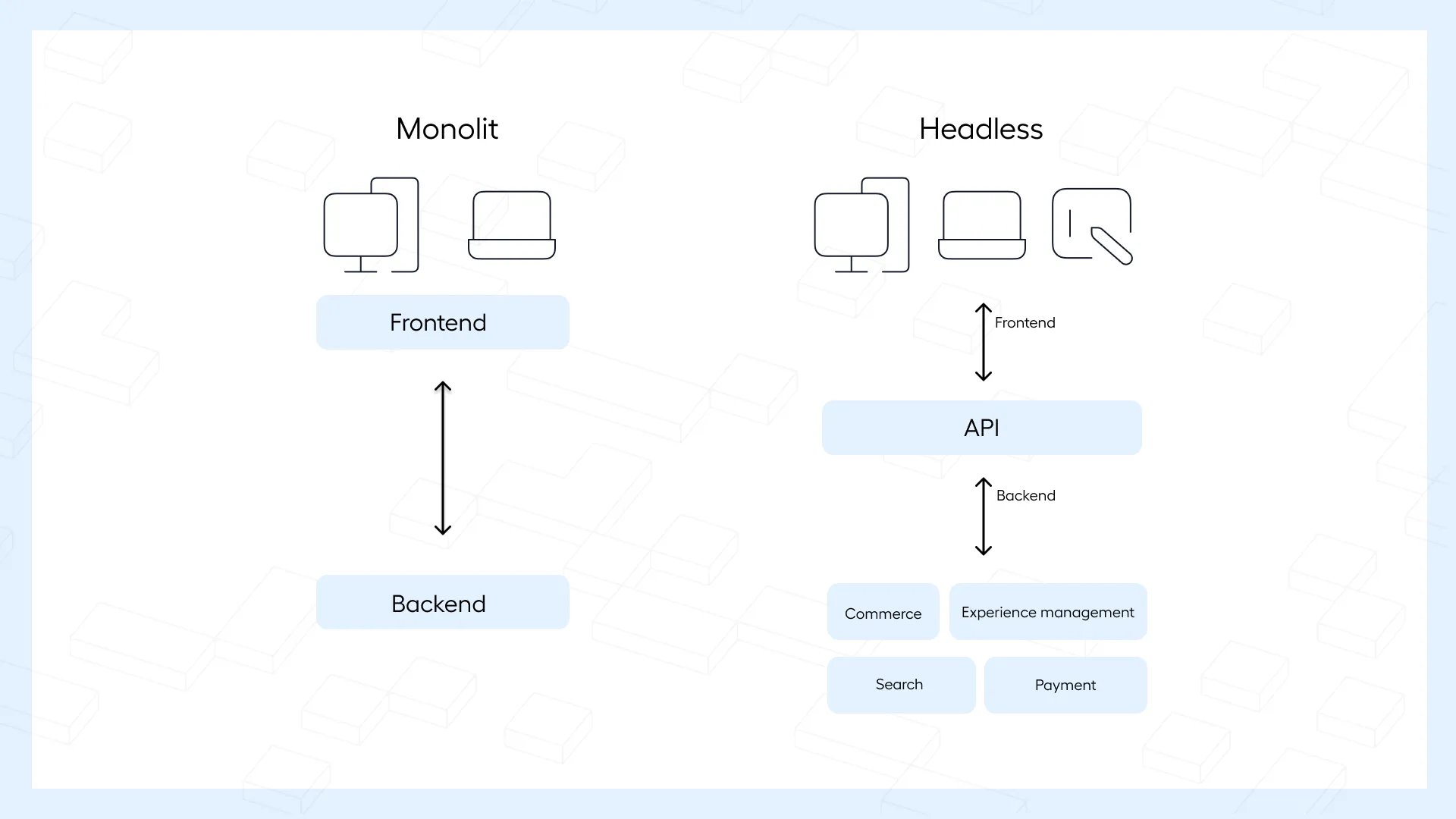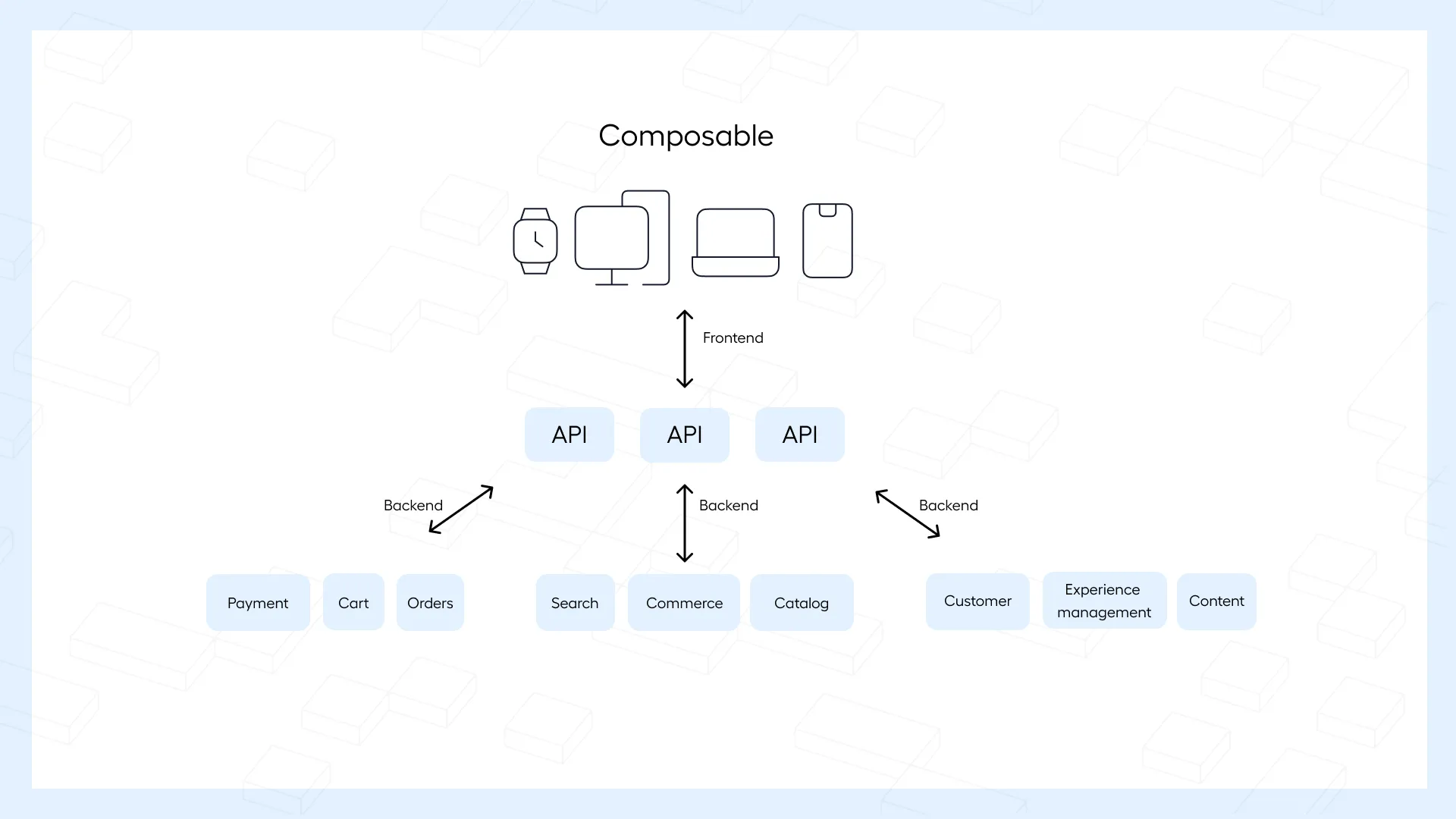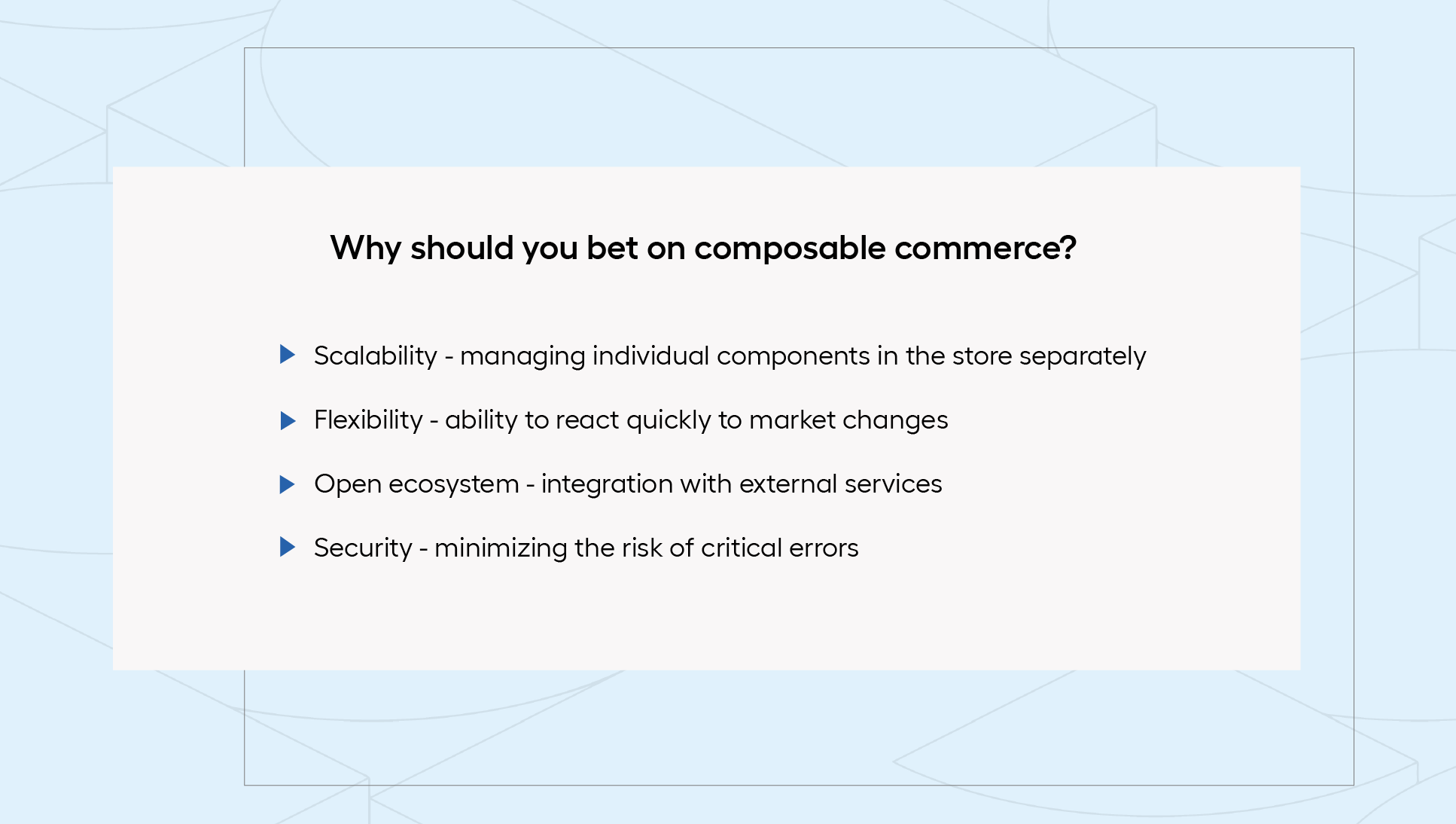Composable commerce - architecture in line with the dynamics of the eCommerce industry
Fast, innovative, and flexible solutions - these are the very qualities eCommerce owners are looking for when designing their own sales platform. The solution that combines all these needs is an innovative approach to creating an online store, or composable commerce. What is this architecture based on? What makes it so unique? What are the benefits of implementing it in your online store? Read the article and find out why major industry leaders such as Zalando, Coca-Cola, and Netflix rely on composable commerce!
From monolith to composable commerce, or the (r)evolution of online store architecture
The goal of modern eCommerce is not only to maximize sales, but also to provide customers with the best shopping experience. Among other things, the speed of ordering, the ability to operate across multiple sales channels or the availability of innovative solutions (e.g. VR, AR, AI) are now important. The growing needs of e-commerce store owners bring with them not only the need to create new technologies, but also the need to change the approach to the design of sales platforms. The architecture of an e-store is no longer seen as an inseparable whole. Nowadays, more and more emphasis is placed on flexibility, which is guaranteed by dividing the architecture into independent, but matching elements. Check out what characterizes the most popular solutions in the industry. Learn the differences between monolithic approach, headless, microservices, and finally, increasingly appearing in industry trends - composable commerce.

Monolit
Traditional eCommerce platforms are most often delivered as all-in-one solutions. What does this mean in practice? Everything needed to create and manage an online store is encapsulated within one system and one code. Each component is thus part of a single platform. Such functions as inventory management, order processing, searching for specific items in the store or managing PIM or CMS systems are handled within a single application.
Although online companies are abandoning monoliths in favor of more flexible solutions, platforms designed in this way can still be found among representatives of e-businesses that relied on simple solutions at the beginning of their operations. A monolith may be sufficient, but only up to a certain point. In the face of constant changes in the market, as well as the need to develop one's own online store, such an architecture can become limiting. Why? Introducing newer and newer functionalities may result in over-complexity of the code (which will hinder the work of developers and increase the risk of errors). Above all, however, you should expect that making changes in one area of the monolith will require modification of the entire platform. If an error occurs during this process, it will be necessary to review the entire platform, and in the situation of critical faults - the risk of disruption of the entire eCommerce will increase. How to avoid it?
Headless commerce
Over time, new devices, apps and sales channels have become part of the buyer's journey. This has contributed to the emergence of headless commerce architecture which is another step towards increased flexibility. The essence of this solution is to separate the frontend from the backend. This approach makes it easy to make changes and test new elements visible to users without interfering with the backend part. This, in turn, minimizes the risk of critical errors that could disrupt the operation of the store. In addition, it also streamlines the process of developing the store in the future, reducing the number of developer hours needed when implementing new functionalities.
Headless also allows to apply solutions consistent with the PWA approach, guaranteeing consumers a unique shopping experience. This gives the sales platform the features of a native mobile application. It is possible, for example, to send push notifications to customers or use location. Such an approach is particularly desirable in the context of the development of mobile commerce and omnichannel strategy (which involves selling in different channels simultaneously).
Mikroserwisy
Growing competition in the industry, however, continues to intensify the need to design solutions that guarantee fast and seamless operation of online stores. In response to the increasingly specific needs of the industry (often requiring complex integrations with external systems and data exchange between them), the idea of microservices was created. What sets it apart? One of the assumptions of this solution is the division of the entire system into individual services. Each microservice is responsible for a specific business function (e.g. payments, product management or returns handling). All elements of the system are fully autonomous and communicate with other microservices in an established standard (and only to the extent necessary for them). This makes it possible to implement and expand specific functionalities without having to update the entire platform. This approach allows you to freely expand your e-store according to your own pace and needs, and to avoid critical errors when implementing updates. However, it should be reckoned with the fact that implementing individual microservices is a time-consuming process and often requires the work of multiple specialists. For this reason, eCommerce owners often choose to combine microservices with other solutions or abandon them altogether.
Composable commerce - what is the phenomenon of this solution?
Imagine a jigsaw puzzle in which each piece stands alone, but their combination allows the final product to be expanded and developed at will. A similar philosophy accompanies composable commerce. With this architecture, the individual components are autonomous, and by integrating them it is possible to build a flexible and scalable online store. What should you know about this approach?

The essence of Composable Commerce is that each component of the platform is independent and combines into a coherent system. Such an effect is achieved first by separating the frontend and backend parts of the platform, and then each functionality on both sides is also implemented separately. Such separation is often confused with microservices, which are accompanied by a similar idea. It even happens that the terms are used interchangeably. However, what should you pay attention to in order to understand the difference between them?
Microservices architecture involves dividing the entire system into individual services. In contrast, individual components in composable commerce, or Packaged Business Capabilities (PBCs), are responsible for meeting specific business requirements. Each PBC responds to an assigned task or function, giving greater flexibility and freedom in composing and personalizing eCommerce. What's more, each PBC can come from a completely different vendor, allowing for even greater diversification.
For example, an eCommerce store may use one PBC for payment processing, another for shipping, and yet another for managing content on the site. All of these elements communicate with each other using APIs, so they can be changed on the fly without worrying that the store will "stop selling." This allows companies that choose this solution to create a platform equipped with unique functionalities.
Architecture basics - why are composable commerce increasingly being chosen?
Companies that have opted for composable commerce-based solutions are outpacing their competitors by 80% in terms of introducing new functionalities - these are the conclusions of a 2023 study by Gartner. What makes this type of architecture one of the most attractive solutions on the market? Learn about the key benefits of the composable idea.
- Scalability - thanks to the fact that each module inside the architecture is dedicated to a different functionality, you can constantly expand your platform with new enhancements. This structure allows you to add and remove components depending on your business requirements, allowing you to easily scale both vertically and horizontally. In this way, you can focus both on improving the customer experience inside the store (e.g. by adding a returns and complaints module) or create a separate version of the platform for B2B contractors or targeting the foreign market (in line with the cross border commerce trend).
- Open ecosystem - composable commerce allows you to integrate with various third-party platforms and services via APIs. This allows you to easily use existing solutions from different vendors and implement new technologies such as artificial intelligence or big data to make your eCommerce more efficient and innovative.
- Fault tolerance and security - the autonomy of components ensures that you can significantly reduce the risk of errors when introducing new solutions. The possible appearance of a mistake will not affect the entire system. In addition, each component can be secured individually, which increases the overall security of the platform.
- Flexibility - Composable architecture ensures speed of response to market changes and new business requirements. The modular structure allows faster testing and implementation of changes. This, in turn, guarantees rapid deployment of new features, improved performance and delivery of a more personalized customer experience, without worrying about your online business being overtaken by competitors.

Will Composable commerce work for your eCommerce as well?
You already know what composable commerce architecture is all about, and you have learned about the key features and benefits of its implementation. In that case, surely the question has entered your thoughts regarding whether this solution will definitely work for your business? In order to know the answer, you should carefully analyze the key areas in your online store. First, think about what are your eCommerce business goals?
If your needs include scalability, personalization and flexibility then composable commerce may be the right solution for you. This architecture will work great for large eCommerce stores managing multiple products or operating on different platforms (e.g. overseas or B2B sales). Smaller eCommerce stores looking to grow should also consider this solution - especially if they are looking to deliver personalized customer experiences and innovative ideas.
Do you bet on composable commerce?
Composable Commerce addresses the growing expectations of eCommerce owners who are looking for fast, innovative and flexible solutions to design their sales platforms. This approach allows for almost immediate implementation of changes, experimentation with innovations and customization of the platform to meet specific business needs, resulting in better sales results and customer satisfaction. At the end of the day, composable commerce is a solution that can improve your e-commerce operation - both now and for the future. Are you ready for a change in your business?



